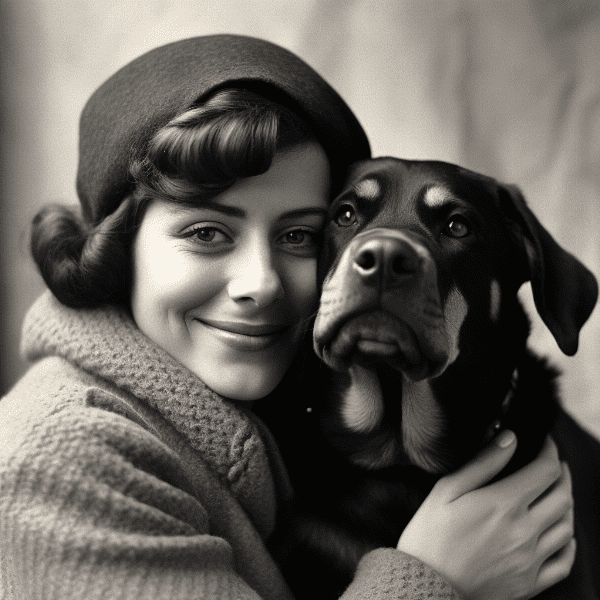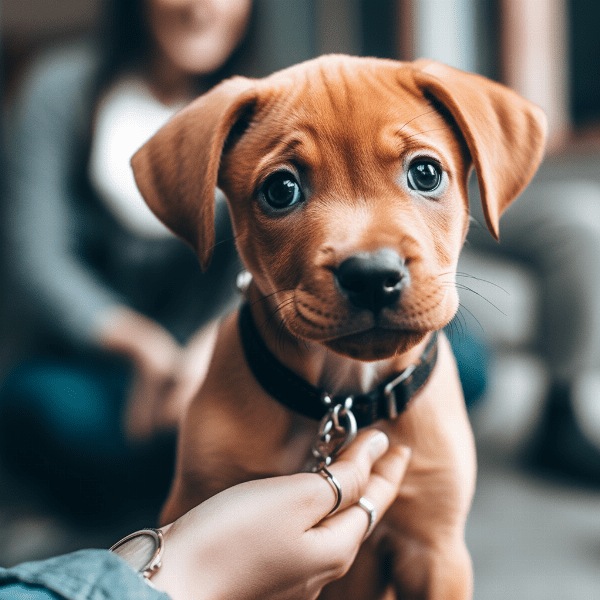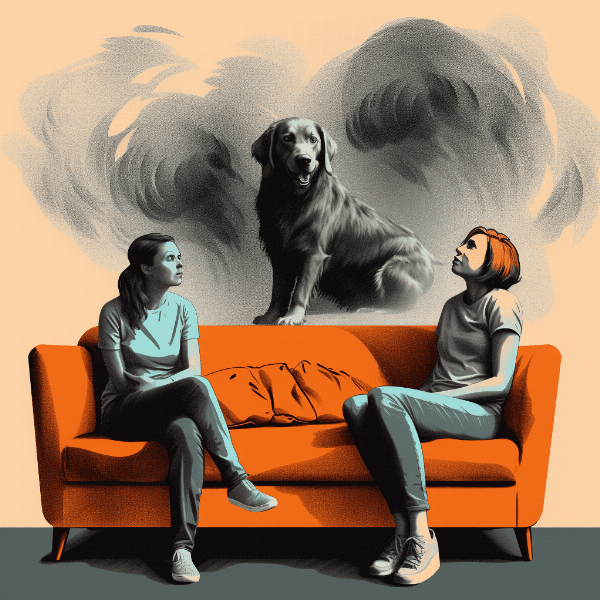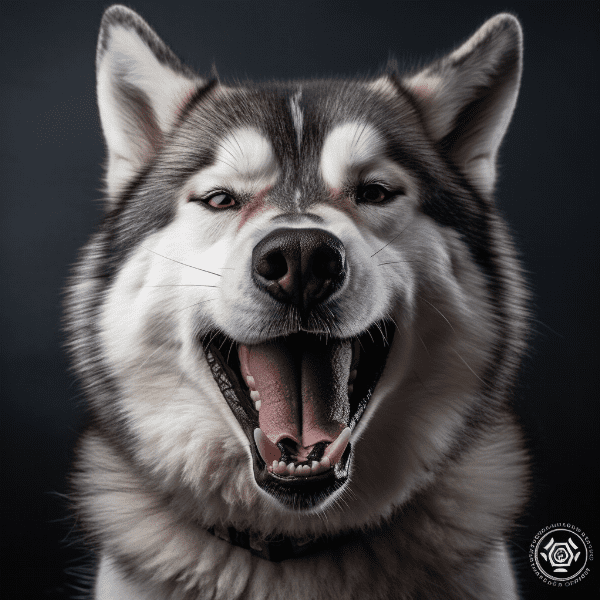Table of Contents
- Introduction to Rottweiler Growling Behavior
- Why Do Rottweilers Growl?
- Types of Rottweiler Growling
- Signs of Aggressive Rottweiler Growling
- Dealing with Rottweiler Growling
- Training Rottweilers to Control Growling
- Socializing Rottweilers to Minimize Growling
- Seeking Professional Help for Rottweiler Growling
- Preventing Rottweiler Growling
- Conclusion: Living with a Rottweiler and Growling Behavior
Introduction to Rottweiler Growling Behavior
As a Rottweiler owner, understanding your dog’s behavior is crucial to maintaining a healthy and happy relationship. One common behavior that Rottweilers display is growling. While growling is a natural way for dogs to communicate, it can be intimidating and concerning, especially for those who are not familiar with Rottweiler behavior. In this guide, we will provide an overview of Rottweiler growling behavior, including the reasons behind it and how to deal with it.
Why Rottweilers Growl
Growling is a normal behavior for dogs and is usually a sign of communication. Rottweilers are known for being protective and loyal dogs, and they may growl to communicate their emotions or protect their owners. It is essential to understand that growling does not necessarily mean aggression, and it is a warning sign that your dog may be uncomfortable or afraid of a situation.
Types of Rottweiler Growling
Rottweiler growling can be classified into different types, depending on the context and intensity of the growling. Play growling is a normal behavior that Rottweilers display when they are happy and excited. However, growling can also indicate frustration, anxiety, or aggression. It is important to distinguish between the different types of growling to understand your Rottweiler’s behavior better.
Dealing with Rottweiler Growling
Dealing with Rottweiler growling can be challenging, especially if you do not understand the reason behind it. The first step in dealing with growling behavior is to identify the cause of the behavior. Once you have identified the cause, you can use positive reinforcement training to address the issue. This involves rewarding your Rottweiler for good behavior and redirecting negative behavior.
Socializing Rottweilers to Minimize Growling
Socializing your Rottweiler is essential to minimizing growling behavior. This involves exposing your Rottweiler to different people, animals, and environments to help them feel comfortable and confident. Socialization can also help your Rottweiler learn how to communicate effectively without growling.
Preventing Rottweiler Growling
Preventing growling behavior in Rottweilers starts with understanding your dog’s behavior and needs. Providing adequate exercise, socialization, and training can help prevent growling behavior. It is also important to monitor your Rottweiler’s behavior and address any issues promptly.
Conclusion: Living with a Rottweiler and Growling Behavior
Rottweiler growling behavior is a natural behavior that can be managed with the right approach. By understanding your Rottweiler’s behavior
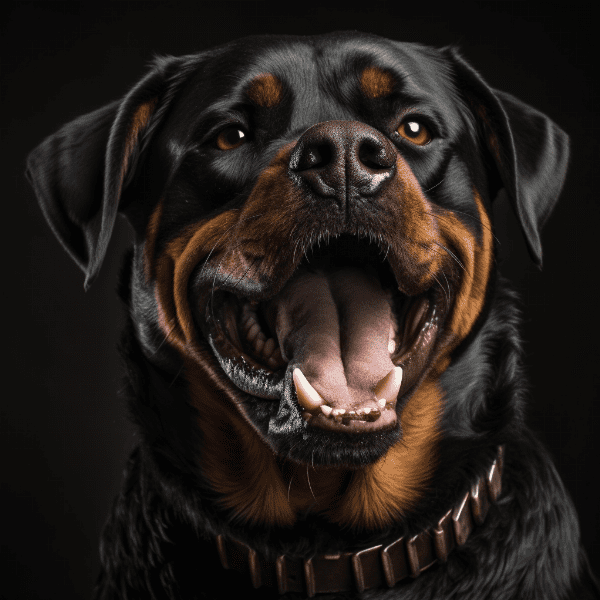
Why Do Rottweilers Growl?
Rottweilers are known for their protective and loyal nature, and growling is a natural way for them to communicate. However, there are several reasons why Rottweilers may growl, and it is essential to understand these reasons to manage their behavior effectively.
Communication
One of the primary reasons why Rottweilers growl is to communicate. Growling can be a way for your Rottweiler to express their emotions, such as excitement or happiness. Rottweilers may also growl to warn others of their presence, especially when they feel threatened or are protecting their owners.
Fear and Anxiety
Rottweilers may also growl out of fear or anxiety. For example, if your Rottweiler is uncomfortable in a new environment or around unfamiliar people or animals, they may growl to indicate their discomfort. It is important to identify the source of your Rottweiler’s fear or anxiety and address it appropriately to prevent growling behavior.
Pain and Discomfort
Another reason why Rottweilers may growl is due to pain or discomfort. If your Rottweiler is experiencing physical discomfort or pain, such as from an injury or illness, they may growl to indicate their discomfort. It is important to seek veterinary attention if your Rottweiler is exhibiting this behavior to ensure that they receive the necessary treatment.
Lack of Socialization and Training
Rottweilers that have not been adequately socialized or trained may also growl more frequently. A lack of socialization can lead to anxiety and fear, which can result in growling behavior. Similarly, a lack of training can result in a lack of communication skills, leading to inappropriate growling behavior.
Territoriality
Rottweilers are territorial dogs and may growl to protect their home or family. They may also growl to warn others to stay away from their territory, such as their food or toys. It is essential to establish boundaries and teach your Rottweiler appropriate behaviors to prevent territorial growling behavior.
Conclusion
In conclusion, Rottweilers growl for various reasons, including communication, fear, pain, lack of socialization and training, and territoriality. Understanding these reasons can help you manage your Rottweiler’s behavior effectively and prevent growling behavior. It is essential to address growling behavior promptly and seek professional help if necessary to ensure that your Rottweiler remains happy and healthy.
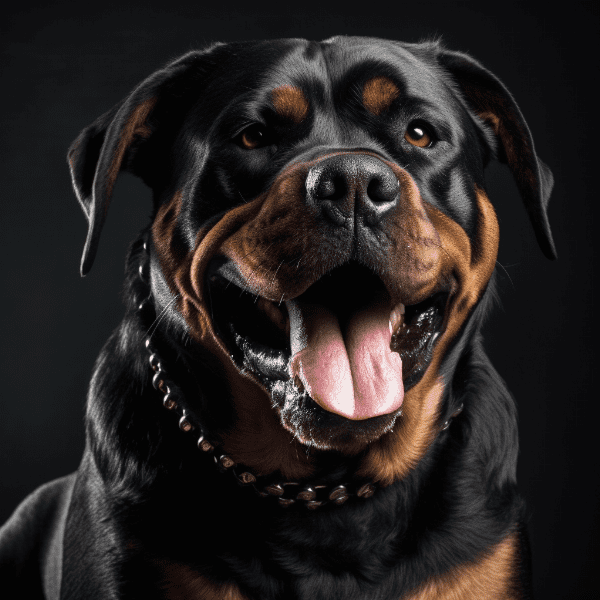
Types of Rottweiler Growling
Play Growling
One type of Rottweiler growling is play growling. This is a normal behavior that Rottweilers display when they are happy and excited. Play growling is usually accompanied by other playful behaviors, such as tail wagging, jumping, and pawing. It is important to understand that play growling is not aggressive behavior and is a natural way for dogs to communicate.
Frustration Growling
Frustration growling is another type of Rottweiler growling that can be concerning for owners. This type of growling occurs when your Rottweiler is unable to get what they want, such as a toy or treat. Frustration growling can also occur when your Rottweiler is restrained or prevented from doing something they want to do.
Anxiety Growling
Rottweilers may also growl out of anxiety or fear. Anxiety growling is often accompanied by other signs of anxiety, such as shaking, pacing, and panting. If your Rottweiler is exhibiting anxiety growling behavior, it is important to identify the source of their anxiety and address it appropriately.
Aggressive Growling
Aggressive growling is a serious behavior that requires immediate attention. This type of growling occurs when your Rottweiler is threatened or feels the need to protect themselves or their family. Signs of aggressive growling may include showing teeth, stiffening of the body, and lunging. If your Rottweiler is displaying aggressive growling behavior, it is important to seek professional help to address the issue.
Territorial Growling
Territorial growling is another type of growling that Rottweilers may display. This type of growling occurs when your Rottweiler is trying to protect their territory, such as their home or yard. Territorial growling can also occur when your Rottweiler is guarding their food or toys. It is important to establish boundaries and teach your Rottweiler appropriate behaviors to prevent territorial growling behavior.
Conclusion
In conclusion, Rottweiler growling can be classified into different types based on the context and intensity of the growling. Understanding the different types of growling can help you identify the underlying cause of your Rottweiler’s behavior and manage it effectively. It is essential to address growling behavior promptly and seek professional help if necessary to ensure that your Rottweiler remains happy and healthy.
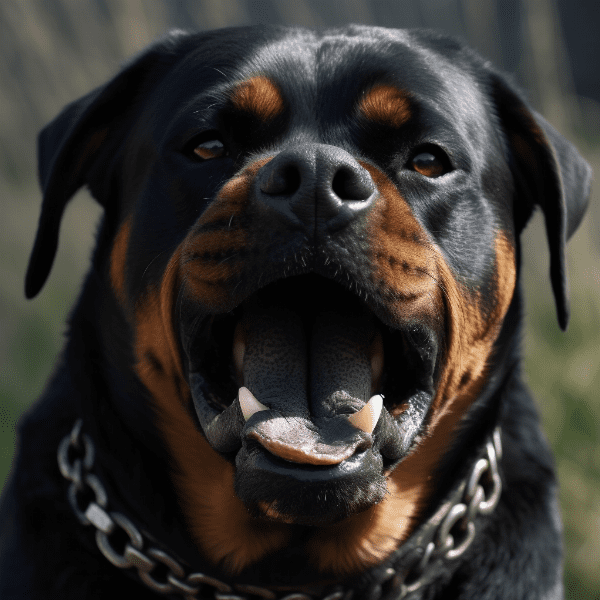
Signs of Aggressive Rottweiler Growling
Aggressive growling is a serious behavior that can be concerning and even dangerous. It is important to understand the signs of aggressive Rottweiler growling to address the issue promptly and prevent potential harm.
Showing Teeth
One of the most apparent signs of aggressive Rottweiler growling is showing teeth. This behavior is usually accompanied by other aggressive behaviors, such as lunging, growling, and stiffening of the body. If your Rottweiler is showing their teeth during growling, it is essential to address the behavior immediately.
Lunging
Lunging is another sign of aggressive Rottweiler growling that can be concerning for owners. This behavior occurs when your Rottweiler moves towards a perceived threat, such as a stranger or another dog. Lunging is usually accompanied by other aggressive behaviors, such as growling and showing teeth.
Biting
Biting is the most severe sign of aggressive Rottweiler growling and can result in serious injury. If your Rottweiler is exhibiting biting behavior, it is essential to seek professional help immediately to address the issue and prevent potential harm.
Conclusion
In conclusion, aggressive Rottweiler growling can be a serious behavior that requires immediate attention. Signs of aggressive growling include showing teeth, stiffening of the body, lunging, and biting. It is important to address aggressive growling promptly and seek professional help if necessary to ensure the safety of your Rottweiler and those around them. Remember that aggressive behavior in Rottweilers can be managed effectively with the right approach and guidance.
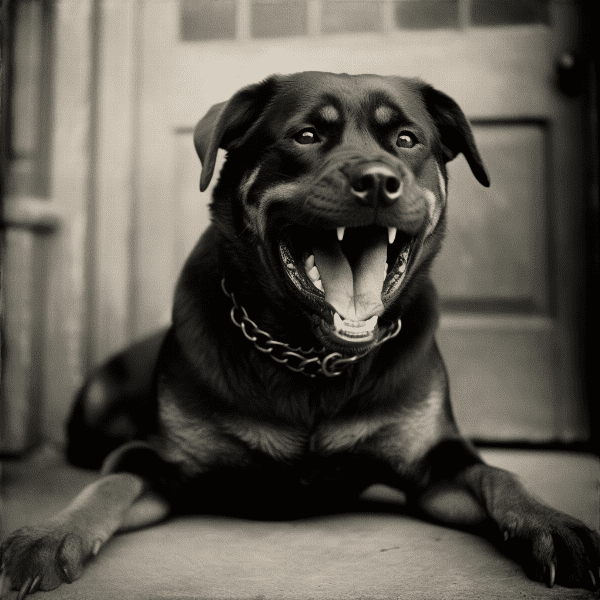
Dealing with Rottweiler Growling
Dealing with Rottweiler growling behavior can be challenging, especially if you do not understand the reason behind it. However, there are several approaches you can take to address the behavior effectively and maintain a healthy relationship with your Rottweiler.
Identify the Cause
The first step in dealing with Rottweiler growling behavior is to identify the cause of the behavior. Growling can be a sign of communication, fear, anxiety, pain, or aggression. Understanding the reason behind your Rottweiler’s growling behavior can help you address the issue effectively.
Socialization
Socialization is another way to deal with Rottweiler growling behavior. Socializing your Rottweiler can help them feel comfortable and confident in different situations and around unfamiliar people and animals. This can help reduce anxiety and fear and prevent growling behavior.
Conclusion
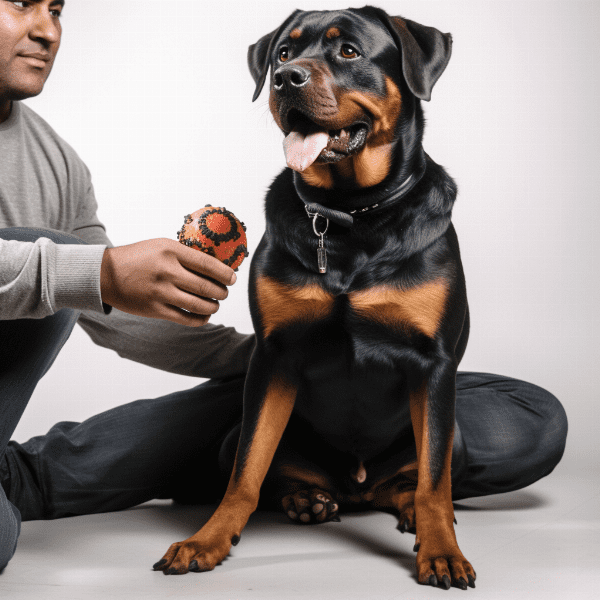
Training Rottweilers to Control Growling
Training your Rottweiler to control growling behavior is essential for maintaining a healthy relationship with your dog. This involves teaching your Rottweiler alternative behaviors to growling and rewarding them for good behavior.
Desensitization Training
Desensitization training is another way to train your Rottweiler to control growling behavior. This training involves exposing your Rottweiler to the source of their growling behavior, such as strangers or other dogs, in a controlled and safe environment. Over time, your Rottweiler will learn to become more comfortable and less reactive to these situations, reducing their growling behavior.
Teaching Alternative Behaviors
Teaching your Rottweiler alternative behaviors to growling is another way to control the behavior. This involves teaching your Rottweiler commands, such as “sit” or “down,” and rewarding them for good behavior. When your Rottweiler learns to associate these commands with positive rewards, they will be more likely to perform them instead of growling.
Conclusion
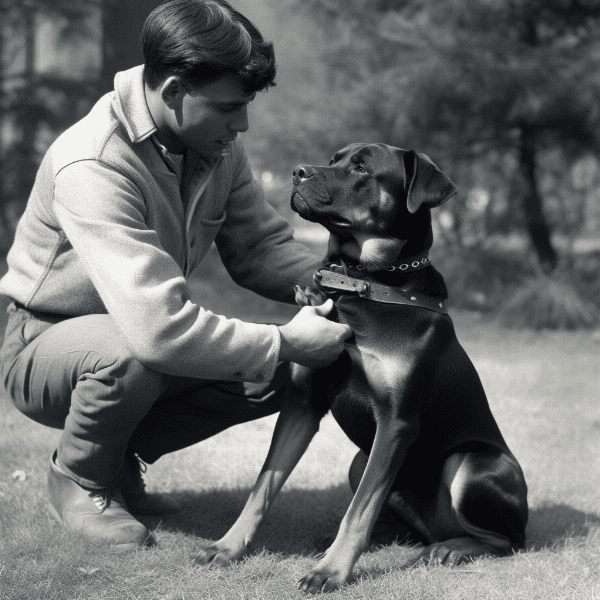
Socializing Rottweilers to Minimize Growling
Early Socialization
Early socialization is important for Rottweilers to learn appropriate behaviors and prevent growling behavior. It is recommended to socialize your Rottweiler between the ages of 3 and 14 weeks, as this is a critical period for socialization. During this time, your Rottweiler should be exposed to different environments, people, and animals to learn appropriate behaviors.
Positive Experiences
Socializing your Rottweiler should involve positive experiences to help them associate socialization with positive outcomes. This can involve treats, toys, and praise for good behavior. It is important to avoid negative experiences that can increase anxiety and fear in your Rottweiler.
Gradual Exposure
Socializing your Rottweiler should involve gradual exposure to different situations and environments. This can help your Rottweiler become more comfortable and less reactive to new situations. Gradual exposure can also help prevent overwhelming situations that can lead to growling behavior.
Conclusion
In conclusion, socializing your Rottweiler is an essential part of minimizing growling behavior. Early socialization, positive experiences, gradual exposure, and consistency are all important in socializing your Rottweiler effectively. Seeking professional help is also necessary for severe or serious growling behavior. With the right approach and guidance, your Rottweiler can learn appropriate behaviors and maintain a healthy and happy relationship with you.

Seeking Professional Help for Rottweiler Growling
If your Rottweiler’s growling behavior is severe or has become a serious issue, it may be necessary to seek professional help. A professional dog trainer or behaviorist can provide guidance on how to address the issue effectively and prevent potential harm.
Assessing the Behavior
The first step in seeking professional help for Rottweiler growling behavior is to assess the behavior. This involves identifying the context and intensity of the behavior and understanding the underlying cause. A professional trainer or behaviorist can help you assess the behavior and provide guidance on how to address the issue effectively.
Developing a Treatment Plan
After assessing the behavior, a professional trainer or behaviorist can develop a treatment plan to address the growling behavior. This may involve positive reinforcement training, desensitization training, teaching alternative behaviors, and socialization. The treatment plan should be tailored to your Rottweiler’s specific needs and behavior.
Training and Education
Seeking professional help for Rottweiler growling behavior can also involve training and education for the owner. A professional trainer or behaviorist can provide guidance on how to train your Rottweiler effectively and how to address the behavior in the future. They can also provide education on Rottweiler behavior and how to maintain a healthy and happy relationship with your dog.
Medical Issues
Sometimes growling behavior in Rottweilers can be caused by underlying medical issues, such as pain or discomfort. A professional trainer or behaviorist can help identify medical issues that may be contributing to the behavior and provide guidance on how to address them.
Conclusion
In conclusion, seeking professional help for Rottweiler growling behavior is necessary for severe or serious behavior. A professional trainer or behaviorist can assess the behavior, develop a treatment plan, provide training and education, and identify underlying medical issues. With the right approach and guidance, Rottweiler growling behavior can be managed effectively and maintain a healthy and happy relationship with your dog.
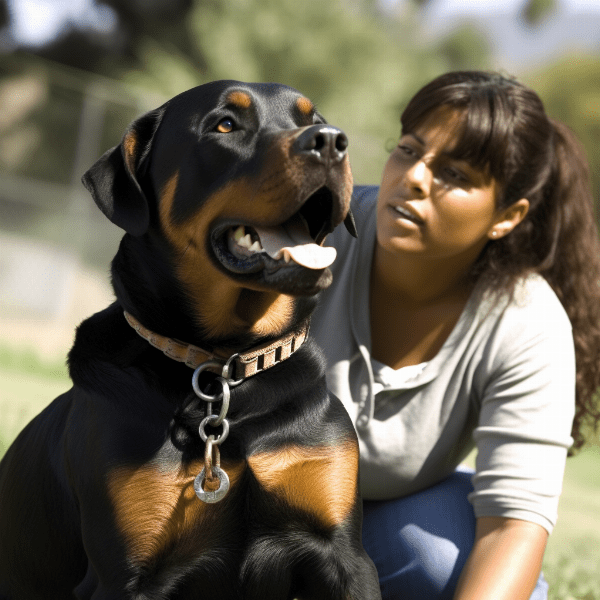
Preventing Rottweiler Growling
Preventing Rottweiler growling behavior involves understanding the causes of the behavior and addressing them appropriately. Here are some tips to prevent growling behavior in Rottweilers:
Socialization
Socializing your Rottweiler is an essential part of preventing growling behavior. Socialization involves exposing your Rottweiler to different situations, people, and animals, and teaching them appropriate behaviors in those situations. This can help reduce anxiety and fear and prevent growling behavior.
Addressing Medical Issues
Growling behavior in Rottweilers can be caused by underlying medical issues, such as pain or discomfort. It is important to address medical issues promptly to prevent growling behavior. Regular veterinary checkups can help identify and address medical issues before they become serious.
Consistency is essential in preventing growling behavior in Rottweilers. This involves exposing your Rottweiler to different situations and environments regularly and reinforcing positive behaviors consistently. Consistency can help your Rottweiler learn appropriate behaviors and prevent growling behavior.
Avoid Punishment
It is important to avoid punishment when preventing growling behavior in Rottweilers. Punishment can increase anxiety and fear in your Rottweiler and lead to more aggressive behavior. Instead, focus on positive reinforcement and redirection to prevent growling behavior.
Conclusion

Conclusion: Living with a Rottweiler and Growling Behavior
Rottweilers are loyal and affectionate dogs, but growling behavior can be a challenge for many owners. Understanding the causes of growling behavior and addressing them appropriately can help prevent and manage the behavior effectively. Here are some key takeaways:
Understanding Growling Behavior
Understanding growling behavior in Rottweilers involves identifying the cause and type of growling behavior. Growling can be a sign of communication, fear, anxiety, pain, or aggression. It is important to understand the context and intensity of the behavior to address it appropriately.
Preventing and Managing Growling Behavior
Preventing and managing growling behavior in Rottweilers involves a positive and effective approach. Socialization, positive reinforcement training, addressing medical issues, consistency, and avoiding punishment are all important in preventing and managing growling behavior.
Seeking Professional Help
Seeking professional help is necessary for severe or serious growling behavior in Rottweilers. A professional trainer or behaviorist can assess the behavior, develop a treatment plan, provide training and education, and identify underlying medical issues.
Living with a Rottweiler
Living with a Rottweiler involves understanding their behavior and needs. Regular exercise, socialization, positive reinforcement training, and consistent routines are all important in maintaining a healthy and happy relationship with your Rottweiler.
Conclusion
In conclusion, understanding and managing growling behavior in Rottweilers requires a positive and effective approach. Socialization, positive reinforcement training, addressing medical issues, consistency, and avoiding punishment are all important in preventing and managing growling behavior. Seeking professional help is necessary for severe or serious growling behavior. With the right approach and guidance, living with a Rottweiler and managing growling behavior can be a rewarding experience.
